What Does the Exclamation Mark Hazard Symbol Mean?
The exclamation mark hazard symbol, prominently displayed within a red diamond-shaped border, indicates moderate health and physical risks, such as skin irritation, respiratory issues, or narcotic effects from exposure to chemicals or other hazardous substances. This symbol, standardized by the Globally Harmonized System (GHS) and required by OSHA, guarantees immediate recognition and uniform hazard communication across various environments.
Its placement is essential in chemical storage areas, laboratories, and workplaces emphasizing safety. Understanding this symbol is crucial for mitigating risks and ensuring regulatory compliance.
To explore more about the implications and applications of the exclamation mark symbol, continue learning.

Key Takeaways
- The exclamation mark hazard symbol warns of moderate risks such as irritants, skin sensitizers, and substances with narcotic effects.
- It is part of the GHS and features a bold exclamation mark within a red diamond border for easy recognition.
- The symbol promotes awareness and adherence to safety measures in environments like chemical storage areas and laboratories.
- Proper handling, storage, and usage procedures are essential to mitigate risks associated with materials marked by this symbol.
- Compliance with OSHA and GHS standards ensures consistent hazard communication and minimizes exposure risks.
Historical Background

The historical background of the exclamation mark hazard symbol reveals its evolution from early warning signs to its standardized usage in modern safety protocols.
Initially, rudimentary symbols communicated potential dangers, often varying significantly in form and interpretation. Over time, the need for a universally recognized alert led to the adoption of more consistent symbols.
The exclamation mark emerged as an effective means to denote caution, primarily due to its emphatic nature. Its adoption in safety contexts was driven by the necessity for clear, immediate recognition of potential hazards.
Through iterative refinements and international collaboration, the symbol became entrenched in safety regulations, facilitating a uniform approach to hazard communication across diverse industries and regions. Its current form is a sign of this evolutionary journey.
Regulatory Standards
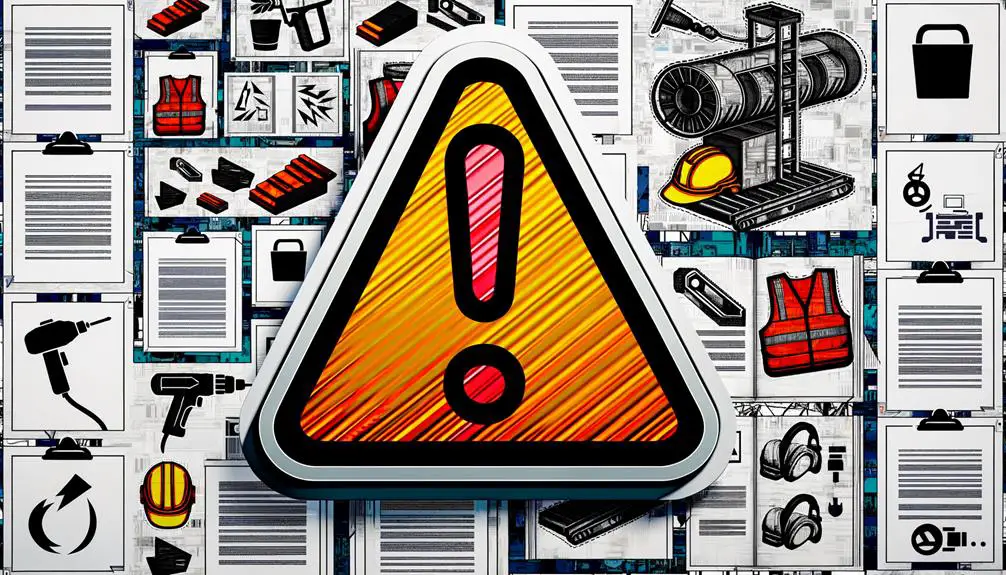
Regulatory standards governing the exclamation mark hazard symbol are vital for ensuring workplace safety and compliance.
Key frameworks include OSHA compliance guidelines, which mandate specific labeling and documentation practices, and the Globally Harmonized System (GHS) pictogram requirements that standardize hazard communication internationally.
Adhering to these standards is essential for minimizing risks and maintaining regulatory compliance.
OSHA Compliance Guidelines
Adherence to OSHA compliance guidelines is critical for maintaining that exclamation mark hazard symbols are used correctly and effectively within the workplace. OSHA mandates specific protocols to uphold workplace safety and communicate potential hazards. These guidelines help in minimizing risks and protecting employees from potential harm.
Compliance with OSHA standards for exclamation mark hazard symbols includes:
- Correct Placement: Guaranteeing symbols are prominently displayed where hazards are present.
- Proper Training: Educating employees on the meaning and implications of the symbols.
- Regular Audits: Conducting routine checks to maintain compliance with OSHA regulations.
These measures are essential in fostering a safe work environment and mitigating risks associated with the identified hazards. Accurate implementation of these guidelines is paramount for organizational safety.
GHS Pictogram Requirements
GHS pictogram requirements mandate strict adherence to specific regulatory standards to guarantee uniformity and clarity in hazard communication across various industries. The Globally Harmonized System (GHS) guarantees that hazard symbols are consistent worldwide, facilitating international trade and enhancing safety protocols.
Each pictogram is defined by precise criteria, including shape, color, and symbol. For instance, the exclamation mark symbol, indicating hazards such as skin irritation or acute toxicity, is a black symbol on a white background with a red diamond border.
Adhering to these specifications is essential for compliance with international safety standards and for making sure that workers and consumers can easily recognize and understand the associated hazards. Non-compliance can result in significant legal and financial repercussions.
Labeling and Documentation Rules
Compliance with labeling and documentation rules is essential for guaranteeing that all hazardous materials are properly identified and communicated according to internationally recognized regulatory standards.
To achieve this, the Globally Harmonized System (GHS) mandates specific guidelines for labeling hazardous substances, which include:
- Pictograms and Hazard Statements: Labels must display appropriate pictograms, such as the exclamation mark, and standardized hazard statements.
- Signal Words: Indicating the severity of the hazard, 'Warning' or 'Danger' must be prominently shown.
- Manufacturer Information: Labels must include the name, address, and contact details of the manufacturer or supplier.
Adhering to these regulations guarantees clear communication of risks, thereby safeguarding health and safety in workplaces and during transportation. Failure to comply can result in legal penalties and increased risk of accidents.
Symbol Design
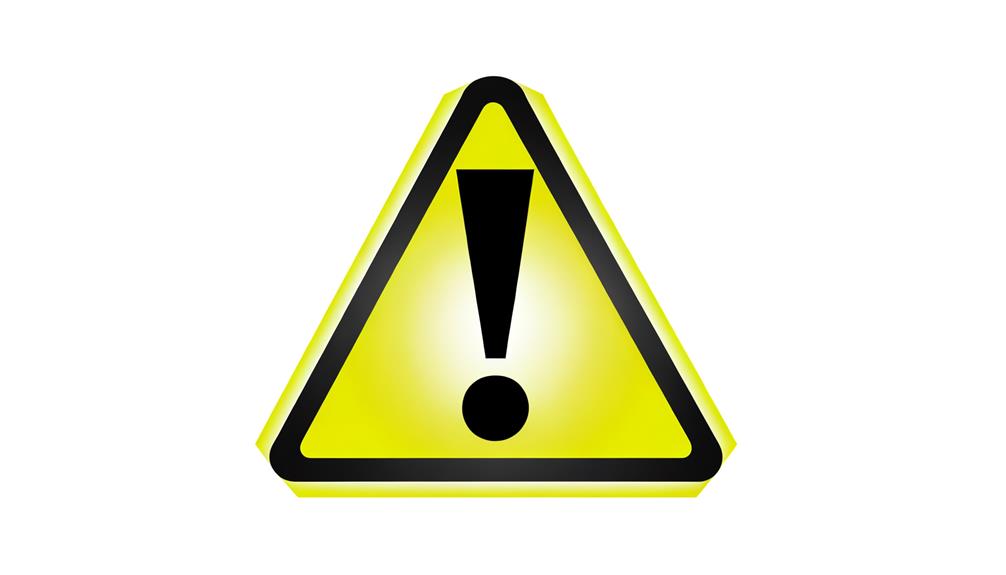
The design of the exclamation mark hazard symbol is meticulously crafted to secure immediate recognition and effective communication of potential risks. The symbol features a bold exclamation mark centered within a diamond-shaped border, typically colored red to command attention.
The simplicity of this design guarantees that it can be easily identified across various contexts and languages, emphasizing the need for caution. The diamond shape, standardized under the Globally Harmonized System (GHS), provides a uniform framework that enhances visibility and consistency.
The clarity of the exclamation mark, devoid of additional embellishments, focuses the observer's attention directly on the symbol, reinforcing its warning message. This design strategy secures the symbol effectively alerts individuals to moderate hazards, promoting safety and awareness.
Common Locations
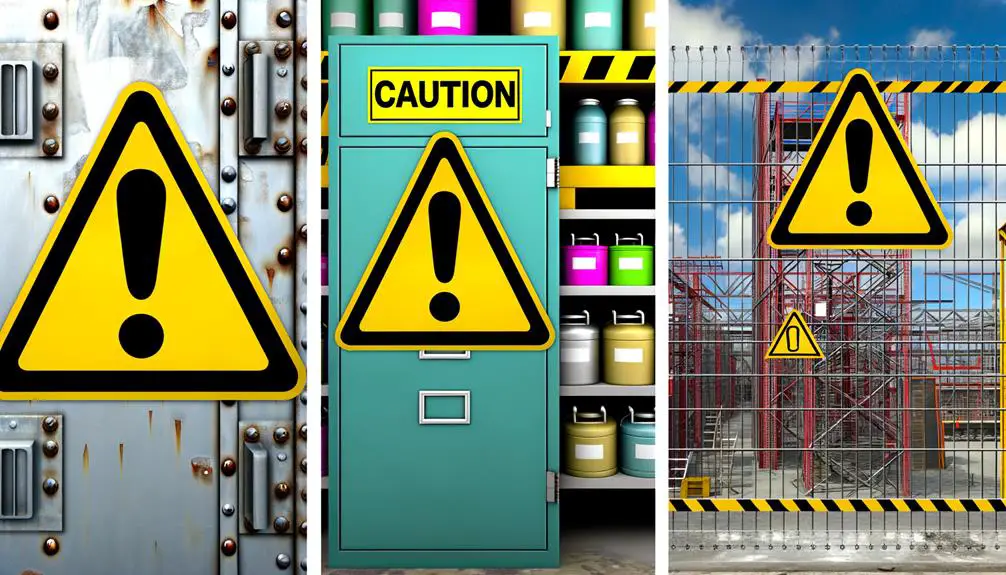
Frequently seen in workplaces, laboratories, and industrial settings, the exclamation mark hazard symbol is strategically placed to warn individuals of moderate risks associated with chemical or physical agents. Its presence is essential in environments where vigilance and adherence to safety protocols are paramount.
Common locations for this symbol include:
- Chemical storage areas: Ensuring that individuals are aware of potential irritants and sensitizers.
- Machinery operation zones: Highlighting equipment that might cause harm if not operated correctly.
- Laboratory benches: Indicating areas where experiments involving hazardous substances are conducted.
Material Classifications
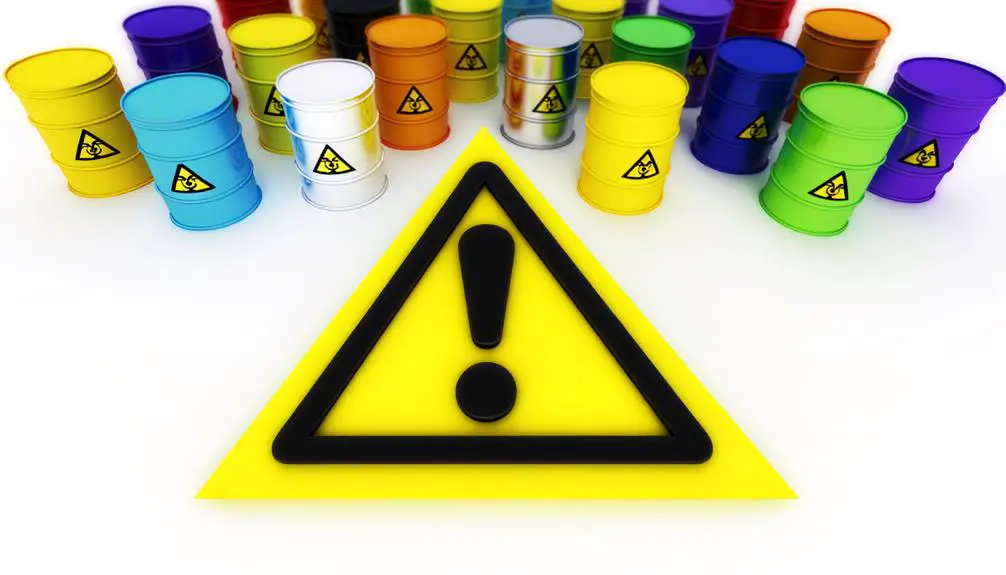
Material classifications under the exclamation mark hazard symbol encompass specific categories of substances that pose moderate health risks, such as irritants, skin sensitizers, and narcotic effects. These materials are distinguished by their potential to cause adverse reactions upon exposure.
Irritants can lead to inflammation or discomfort in eyes, skin, or respiratory passages. Skin sensitizers may induce allergic reactions after repeated exposure, causing symptoms such as rashes or inflammation. Substances with narcotic effects can impair cognitive and motor functions, resulting in dizziness or drowsiness.
The classification under this symbol guarantees appropriate precautions are taken to mitigate risks, highlighting the necessity for proper handling, storage, and usage procedures to minimize exposure and guarantee safety in various environments.
Health Hazards
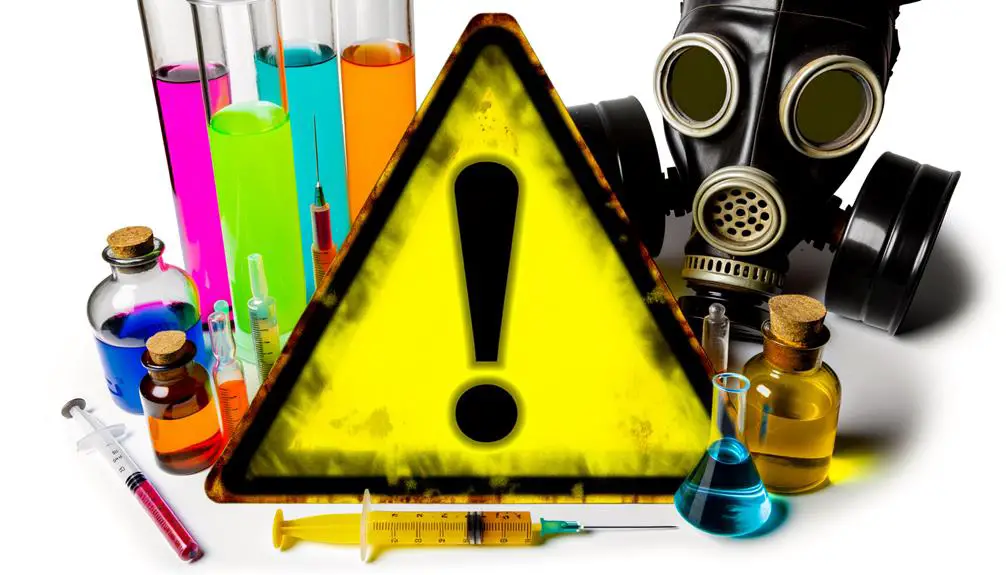
Understanding health hazards associated with the exclamation mark hazard symbol is essential for ensuring safe practices in occupational and environmental settings. This symbol signifies substances that pose various health risks upon exposure.
These hazards can include:
- Irritation: Chemicals that cause skin or eye irritation, leading to redness, swelling, or discomfort.
- Sensitization: Agents that provoke allergic reactions or respiratory sensitization upon repeated exposure, causing long-term health implications.
- Acute Toxicity: Substances that can cause immediate harmful effects when inhaled, ingested, or absorbed through the skin, potentially resulting in serious health issues or fatality.
Recognizing these hazards enables the implementation of appropriate safety measures, including personal protective equipment (PPE) and proper handling protocols, thereby mitigating risk and ensuring a safer environment for all.
Environmental Risks

The exclamation mark hazard symbol also indicates potential environmental risks, particularly those associated with chemical spills and improper waste disposal.
Chemical spills can lead to the contamination of soil and water sources, posing significant threats to ecosystems and human health.
In addition, improper waste disposal can result in the release of hazardous substances, exacerbating pollution and endangering wildlife.
Chemical Spill Dangers
How do chemical spills pose significant environmental risks, leading to long-term damage to ecosystems and biodiversity?
Chemical spills introduce hazardous substances into natural habitats, disrupting ecological balance and harming wildlife. These spills can infiltrate soil and water systems, causing widespread contamination and degrading the quality of these essential resources. The resulting environmental impact can be catastrophic, with detrimental effects persisting for decades.
Key environmental risks include:
- Water Contamination: Pollutants can seep into groundwater and surface water, affecting drinking water supplies and aquatic life.
- Soil Degradation: Toxic chemicals can render soil infertile, impacting plant growth and agricultural productivity.
- Biodiversity Loss: Exposure to harmful substances can lead to the death of species, reducing genetic diversity and ecosystem resilience.
Understanding these risks underscores the urgency for stringent chemical management practices.
Waste Disposal Concerns
Effective waste disposal is critical for mitigating environmental risks and preventing contamination of natural resources. Improper disposal of hazardous materials, often marked by the exclamation mark hazard symbol, can leach toxins into soil and water bodies, adversely affecting ecosystems and human health.
Regulatory compliance necessitates strict adherence to protocols for segregating, handling, and disposing of such waste. Specialized facilities are required to treat and neutralize hazardous substances, ensuring they do not pose a lasting threat to the environment. Additionally, ongoing monitoring and risk assessment are essential to identify potential leaks or breaches in containment systems.
In-depth waste management strategies, including recycling and safe disposal, are paramount to safeguarding environmental and public health from the dangers posed by hazardous waste.
Safety Precautions
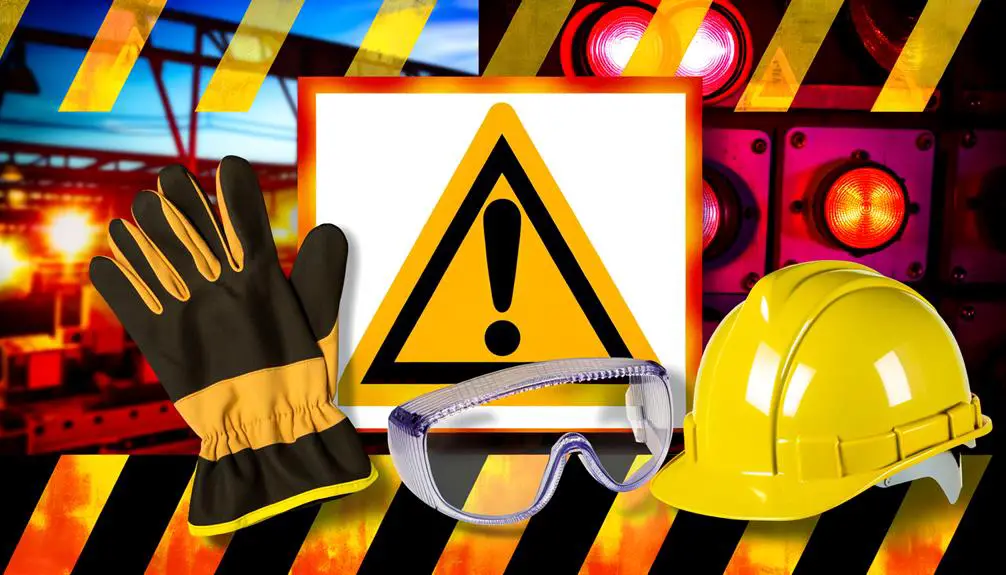
To safeguard the utmost safety when encountering materials marked with an exclamation mark hazard symbol, it is crucial to comprehend and meticulously follow the prescribed safety precautions. These precautions are crafted to minimize risks linked with exposure to potentially harmful substances.
Key measures to observe include:
- Personal Protective Equipment (PPE): Always wear suitable PPE such as gloves, goggles, and masks to shield against accidental exposure.
- Ventilation: Ensure the working area is well-aerated to evade inhalation of harmful fumes or vapors.
- Storage and Handling: Store materials in properly labeled containers and handle them according to specified guidelines to prevent accidental spills or reactions.
Adherence to these precautions is vital for maintaining a safe working environment and preventing health hazards.
Industry Applications
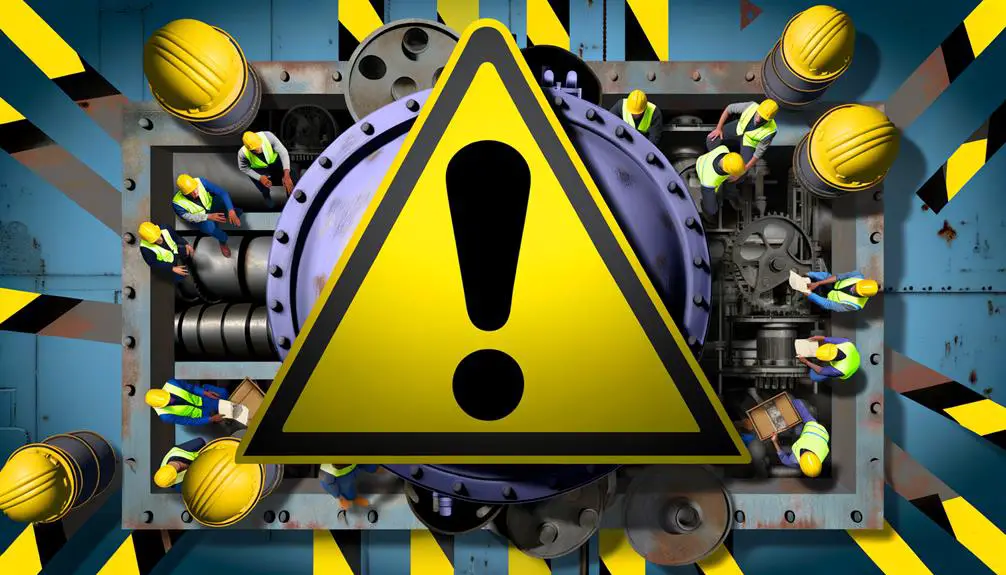
The exclamation mark hazard symbol plays a pivotal role across various industries by reinforcing workplace safety standards and ensuring the correct identification of hazardous chemicals.
Its presence mandates adherence to stringent regulations and highlights the necessity for thorough compliance training programs.
Workplace Safety Standards
Adherence to workplace safety standards is vital for maintaining a secure environment for their workers, especially when dealing with possibly dangerous materials indicated by the exclamation mark hazard symbol. Compliance with these standards involves several crucial practices:
- Regular Training: Providing employees with frequent training sessions on hazard recognition and safe handling procedures.
- Proper Labeling: Guaranteeing all hazardous materials are clearly labeled with the appropriate hazard symbols and safety information.
- Safety Audits: Carrying out consistent safety audits to identify and mitigate potential risks in the workplace.
These measures not only improve employee safety but also ensure regulatory compliance, reducing the likelihood of workplace incidents and promoting a culture of safety and awareness within the industry.
Hazardous Chemical Identification
Understanding how hazardous chemicals are identified in various industries is vital for guaranteeing proper handling, storage, and usage, thereby minimizing potential risks to workers and the environment.
The Globally Harmonized System (GHS) of Classification and Labeling of Chemicals provides standardized criteria for labeling hazardous substances.
One prominent symbol within this system is the exclamation mark, which indicates a chemical that poses moderate health hazards such as skin irritation, respiratory issues, or environmental harm.
Industries must meticulously follow these guidelines to accurately label and document all hazardous materials. This ensures that personnel can quickly recognize and understand the risks associated with specific chemicals.
Proper identification is essential for implementing adequate safety measures, emergency responses, and regulatory compliance.
Compliance Training Importance
In many industries, rigorous compliance training is essential to make certain that employees are well-versed in safety protocols and regulatory standards. This training guarantees that personnel recognize and correctly respond to the exclamation mark hazard symbol, which signifies potential health risks such as skin irritation or respiratory issues. Effective compliance training can prevent workplace accidents, reduce legal liabilities, and foster a culture of safety.
Key industry applications of compliance training include:
- Manufacturing: Guarantees safe handling of machinery and chemicals.
- Healthcare: Maintains adherence to sanitation and patient safety standards.
- Construction: Educates workers on personal protective equipment (PPE) and site hazards.
Comprehensive training programs not only safeguard employees but also contribute to operational efficiency and regulatory compliance.
Misinterpretations

Despite its clear design, the exclamation mark hazard symbol is often subject to various misinterpretations that can lead to safety oversights.
One common misunderstanding is mistaking the symbol for a general warning without recognizing the specific hazards it encompasses, such as skin irritation, eye damage, or respiratory issues.
In addition, some individuals erroneously believe the symbol indicates a minor risk, failing to appreciate the potential severity of the dangers involved. This misconception may result in inadequate protective measures.
Moreover, the symbol's resemblance to other warning signs can cause confusion, especially in multicultural environments where symbols may have different meanings.
Addressing these misinterpretations through extensive training and clear communication is pivotal to ensuring proper safety protocols are followed.
Conclusion
The exclamation mark hazard symbol serves as an essential warning in various contexts, similar to a lighthouse guiding ships away from danger. Its history, regulatory standards, and design reflect its crucial role in alerting individuals to potential risks.
Found commonly in diverse locations and associated with specific material classifications, the symbol underscores environmental hazards and necessitates stringent safety precautions.
Understanding its proper use and avoiding misinterpretations are crucial for ensuring safety across multiple industries.






